Algoma Public Health
Community Health Profile - 2018
Download a pdf version of the Algoma Community Health Profile.
Table of Contents
Message from the Medical Officer of Health
Acknowledgments
Executive Summary
Chapter 1: Demographics
Chapter 2: Life Expectancy
Chapter 3: Maternal Health
Chapter 4: Child and Youth Health
Chapter 5: Infectious Disease
Chapter 6: Injuries
Chapter 7: Chronic Disease
Chapter 8: Substance Use and Mental Health
Data Sources
Message from the Medical Officer of Health
Public health is at work every day in our communities. Public health is happening when we turn on the tap each morning. Public health is happening when we spend our days learning and working in environments that are free from hazards like tobacco smoke. Public health is happening when we come together as friends and family to share a meal, enjoy the beach, relax at the spa, or hit the trail.
The team at Algoma Public Health works with many partners in countless different ways to protect and promote the health of our communities, from supporting new moms with breastfeeding, to building strong infection prevention and control practices in numerous public settings.
Public health is not a solo sport. It takes the organized efforts of diverse community partners to achieve good health for all and to make sure that our resources go toward priority groups who have the greatest health needs.
As the Medical Officer of Health, the community of Algoma is my patient. And every so often, Algoma Public Health conducts a thorough review of our local health data as part of a community check-up. The results, summarized in this Community Health Profile, help us all to identify key health issues in Algoma and describe who is most affected within our population. This important information allows us to set priorities and take public health action for those who need it most.
We at Algoma Public Health are grateful for the ongoing privilege of working with the people of our communities to achieve better health for all. And each and every single one of us has a role to play to make public health happen. I warmly invite you to read and share this Community Health Profile for Algoma as we continue on our journey together toward healthier communities.
Acknowledgments
Algoma Public Health gratefully acknowledges the contributions of the following individuals and groups, whose expertise and dedication have made this report possible:
Data Analysis and Report Writing: Hilary Cutler, Dr. Jennifer Loo and Jordan Robson
Design, Dissemination and Evaluation: Jasmine Bryson, Hilary Cutler, Dr. Jennifer Loo, Sarah McBain, Trina Mount, Jordan Robson and Leonardo Vecchio.
Internal Review: Dr. Marlene Spruyt and the following internal teams: Community Mental Health, Community Wellness, Environmental Health, Healthy Growth and Development, Infectious Disease and the School Health team.
External Review: Dr. Emily Groot, Erica Sawula and Dr. Ariella Zbar.
Executive Summary
This Community Health Profile gives a snapshot of health across the District of Algoma Health Unit.
Algoma residents enjoy good health in many ways. There have been very few major outbreaks of vaccine-preventable disease in the past decade, and our children and youth are doing better than their Ontario counterparts when it comes to staying up-to-date with immunizations. Most people in Algoma report positive mental health. In fact, nine out of ten Algoma residents say we feel satisfied or very satisfied with our lives.
Algoma communities also have important health challenges. Overall, life expectancy is not as high in Algoma compared to Ontario. When we look deeper, we find that three out of every four premature deaths in Algoma can be avoided by healthy actions.
One in four women smoke during pregnancy in Algoma, which means some children are exposed to the harms of tobacco even before they are born. In fact, 30% of Algoma residents are still smokers, which is double Ontario’s smoking rate. Not surprisingly, Algoma has higher lung cancer death rates than Ontario. Hepatitis C is another public health problem where prevention is key. Hepatitis C rates are very high and still climbing in Algoma, even though this is now a curable disease, and it can be completely prevented by always using sterile needles and following good practices in infection prevention and control.
Like most Ontarians, Algoma residents can do more when it comes to healthy eating, active living, and cutting down on alcohol. Other priority public health issues include injury prevention, and meeting the health needs of individuals and their families who live with substance use and mental illness.
Algoma’s Community Health Profile highlights both public health successes that we can celebrate, and priority health concerns that our communities need to focus on. The data and health information in the following chapters can help keep this vital conversation going: let’s talk about what we can do together – with our family, friends, neighbors and coworkers, in all the spaces where we live, work and play – for healthier communities.
Chapter 1: Demographics
|
Acronym: NE LHIN: North East Local Integration Network
Important Stats: Age Income Education Employment |
Key Messages:
- Algoma’s population is aging, with a greater proportion of seniors aged 65 years and older living here, compared to the NE LHIN and Ontario.
- Algoma is home to a higher proportion of Indigenous people than Ontario.
- The majority of Algoma residents have completed high school and are employed.\
- A significant number of Algoma residents live in low income, particularly children and youth.
- The majority of Algoma residents have a regular health care provider.
Geography
- Algoma Public Health’s boundary covers over 41,000 square kilometers and contains 21 municipalities, two large unorganized areas and numerous First Nation communities. The communities stretch over an eight-hour drive along Highway 17 from Spanish in the east to White River in the north. Note that Algoma Public Health’s boundary differs slightly from the District of Algoma or the Census Division of Algoma, which are commonly used in other settings by Statistics Canada.
- Algoma Public Health is one of 5 public health units whose regions are served by the North East Local Health Integration Network (NE LHIN). The NE LHIN spans nearly 400,000 square kilometers andalso includes the sub-regions of Cochrane, Sudbury/Manitoulin/Parry Sound, Nipissing/Temiskaming, James and Hudson Bay Coasts. The large geographic region of the NE LHIN can also be broken up into five health units: Algoma Public Health, North Bay Parry Sound District Health Unit, Porcupine Health Unit,Public Health Sudbury & Districts and Timiskaming Health Unit.
Population and age
- Algoma Public Health’s population in 2016 was 113,084 people.¹ For context, in 2016, the NE LHIN’s population was 551,801² and Ontario’s population was 13,448,494 people.¹
- The average age of an Algoma resident is 45.5 years old.¹ This is higher than the average age of a NE LHIN resident¹ at 43.7 years old and an Ontario resident² at 41.0 years old. An alternative method of looking at age is to use the median, which is a measure that is less easily skewed by extreme values in the population. The median age of an Algoma resident is 49.1 years old,¹ which compares to 46.1 and 41.3 years old in the NE LHIN² and Ontario¹ respectively.
- 23.7% of Algoma’s population is aged 65 years and over¹. By 2026, residents aged 65 years and older are projected to represent 30.4% of Algoma’s population, and 34.1% in 2036.³ Algoma has a higher percentage of seniors than both the NE LHIN (20.6%)² and Ontario (16.7%).¹
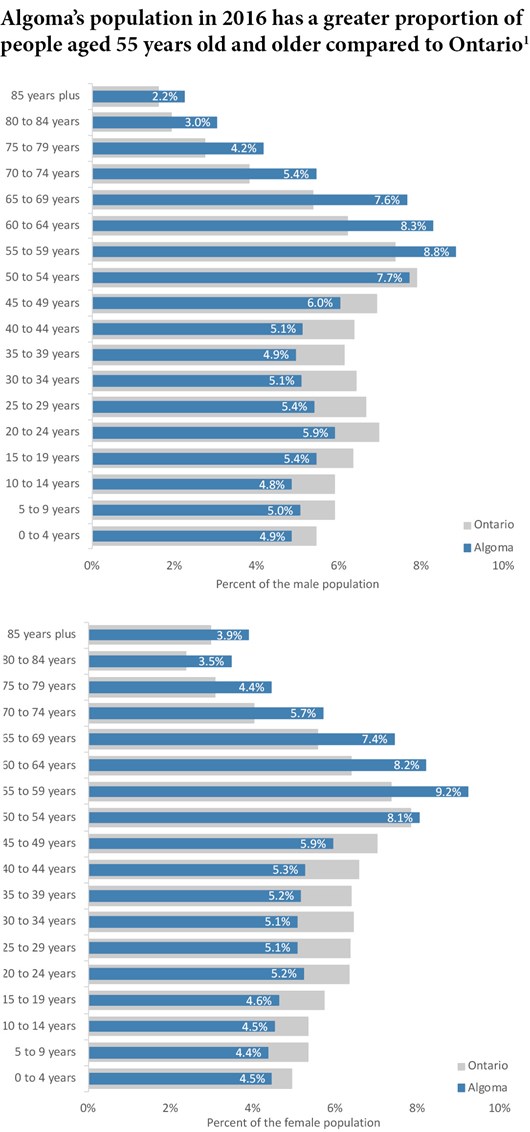
Key social determinants of health
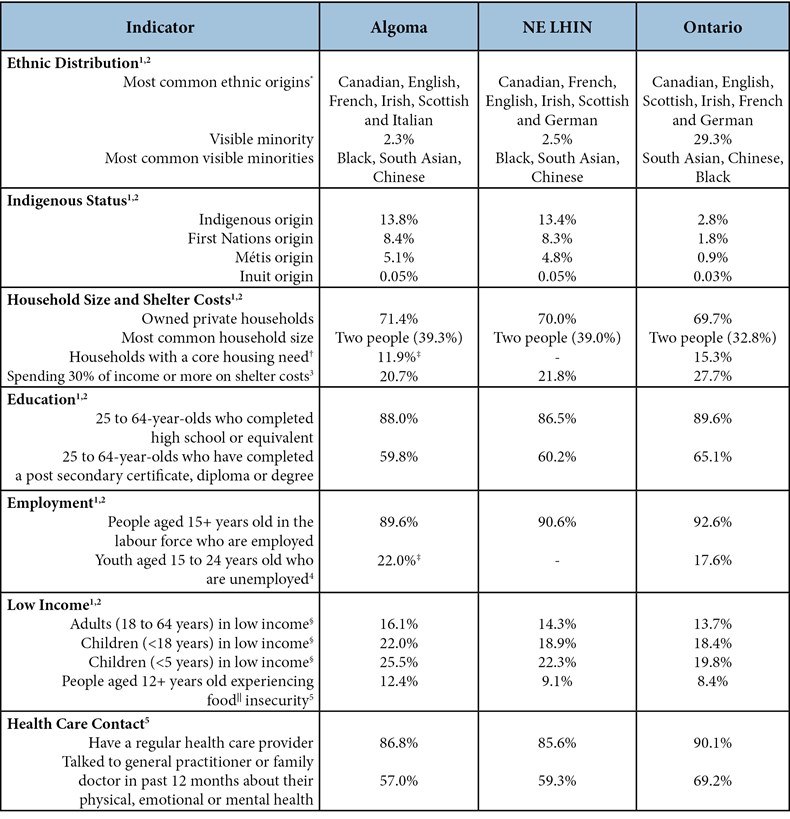
Social determinants of health
The social determinants of health (SDOH) is a term used to describe a broad range of personal, social, economic and environmental factors that influence our health. The main determinants include: income and social status, employment and working conditions, education, childhood experiences, discrimination, social supports, physical environments, healthy behaviors, access to health services, biology, gender and culture.¹
- The communities and municipalities in Algoma differ with respect to employment, income levels and residents. Median income after taxes of individuals among communities in Algoma ranges from $17,760 to $43,136.² The overall median income after taxes in Algoma is $29,267,³ which compares to $30,680 in the NE LHIN4 and $30,641 in Ontario.² The unemployment rate across Algoma communities ranges from 0% to 28.6%,¹ compared to the 10.4% overall rate in Algoma² and 7.4% rate in Ontario.² The youth unemployment rate across Algoma* communities ranges from 0% to 50.0%,¹ compared to the 22.0%¹ overall rate in Algoma and 17.6% in Ontario.¹
- More in-depth information on key measures of the social determinants of health can be found below.
|
Creating healthier communities goes beyond health care. Healthy communities offer the basic foundations of health for every person, from safe homes to good education and job opportunities.5
Let’s keep the conversation going with our community leaders and elected officials. Let’s work to build healthy public policy so that all of our communities in Algoma can be vibrant, healthy places to live, work and play. |
Chapter 2: Life Expectancy
|
Acronyms:
NE LHIN: North East Local Integration Network SIDS: Sudden infant death syndrome
Important Stats:
Life Expectancy Infant mortality All-cause mortality Premature and avoidable mortality |
Key Messages
- A baby boy and girl born in Algoma are expected to live to 76.0 and 82.3 years respectively.
- Infant mortality is higher in Algoma compared to Ontario.
- Algoma’s all-cause mortality rate has decreased since 2000 but still remains higher than the province.
- The leading causes of death in Algoma are heart disease, lung cancer and dementia.
- 3 out of every 4 premature deaths in Algoma are avoidable.
Life expectancy at birth
- A baby boy born in Algoma is expected to live to 76.0 years old.¹ By comparison, life expectancy at birth for males is 76.9 years in the NE LHIN and 80.1 years in Ontario.¹‚²
- A baby girl born in Algoma is expected to live to 82.3 years old.¹ By comparison, life expectancy at birth for females in the NE LHIN is 82.2 years and 84.4 years in Ontario.¹‚²
On average, females have a longer life expectancy at birth than males in Algoma, the NE LHIN and Ontario.
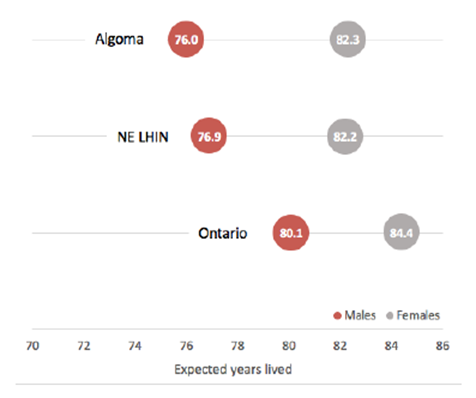
Infant mortality
Since 2000, on average there are 7.4 infant* deaths a year in Algoma. ³,4
- Between the period of 2000 to 2012, the total infant mortality rate† in Algoma was 7.5 per 1,000 births, which was comparable to the NE LHIN at 6.4 per 1,000 births but significantly higher than Ontario at 5.0 per 1,000 births.³‚4
- The top causes of infant mortality in Algoma are sudden infant death syndrome (SIDS) and extremely low birth weight.5
All-cause mortality
- Algoma’s death rates from all causes have gone down since 2000, but are still higher compared to Ontario.¹‚² Algoma’s 2012 all-cause mortality rate‡ was 844.6 deaths per 100,000 population,¹‚² which is very similar to the NE LHIN rate‡ at 830.8 deaths per 100,000 population.²,6
- Between 2008 and 2012, Algoma had a higher all-cause mortality rate across all age groups compared to Ontario.¹‚² This observation holds true for males and females compared to Ontario.¹‚² Algoma’s ¹‚² pattern of all-cause mortality is similar to the NE LHIN²,6 across all age groups.
Leading causes of mortality
- The top 3 causes of death for Algoma residents are heart disease, lung cancer and dementia.¹
- Algoma residents are more likely to die from heart disease, lung cancer and chronic lung disease compared to Ontario residents.¹
- A more detailed breakdown of the leading causes of death can be found below.
Leading causes of mortality (2009-2012):
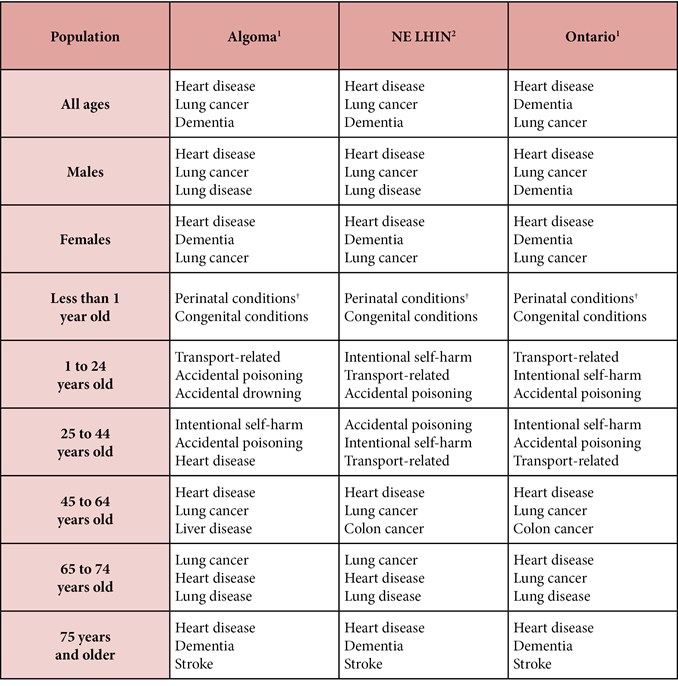
Premature and avoidable mortality
- 3 of every 4 premature deaths in Algoma can be avoided by healthy behaviors, effective public health interventions or appropriate medical treatment.¹
- When someone dies before the age of 75, this is considered a premature death.² In Algoma, 42.0% of deaths are premature¹ compared to 41.5% in the NE LHIN and 37.3% of deaths in Ontario.¹
- The leading causes of avoidable deaths in Algoma for 2012 were lung cancer, heart disease, chronic lung disease, liver disease and intentional self-harm.¹ These causes can be prevented through positive health behaviors, including:4
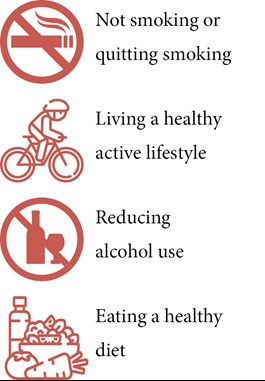
|
The places where we live, work and play can be supportive environments, where the healthy choice, is the easy choice for everyone.5 Talk with family, friends, classmates, colleagues, and community leaders, about how we can all work together to create supportive environments for health in our communities. |
Chapter 3: Maternal Health
|
Acronyms:
NE LHIN: North East Local Health Integration Network SIDS: Sudden infant death syndrome ADHD: Attention deficit hyperactivity disorder FASD: Fetal alcohol spectrum disorder
Important Stats:
Fertility rate |
Key Messages:
- About 1,000 babies are born each year in Algoma.
- Babies tend to be born to younger mothers in Algoma compared to in Ontario.
- Adolescent pregnancy continues to be a concern as many teenage mothers in Algoma do not do as well when it comes to having a healthy pregnancy.
- Key areas of improvement for healthy pregnancies in Algoma include supporting mothers to take folic acid before and during pregnancy, supporting mothers to not smoke during pregnancy and addressing mothers’ mental health concerns during and after pregnancy.
Births in Algoma
- On average, 1,034 babies are born each year in Algoma and the birth rate has been stable for the past 10 years.¹‚² In 2016, there were 8.8 births per 1,000 residents in Algoma.²
- Women of reproductive age* in Algoma have slightly more births compared to in Ontario.² This is especially true for Algoma women younger than 30 years of age. In 2016, the crude fertility rates per 1,000 women of reproductive age* were as follows:²
»» 45.1 in Algoma,
»» 45.5 in the NE LHIN, and
»» 41.2 in Ontario.
Mothers in Algoma
- Algoma women who give birth are about 28 years old, on average. This is similar to the North East LHIN (28.1 years old), and younger compared to Ontario (30.7 years old)
- Babies tend to be born to younger mothers in Algoma compared to Ontario.²
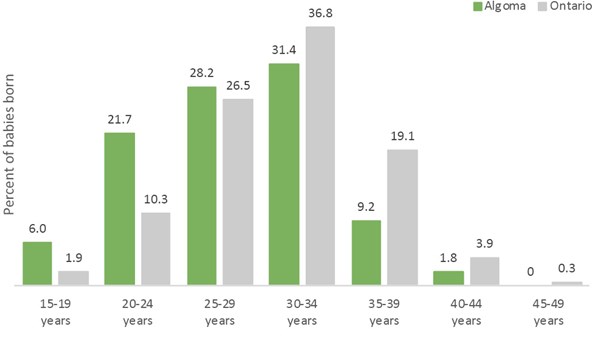
Focus on adolescent pregnancy
- The adolescent pregnancy rate in Algoma has gone down over time, but is still nearly double the Ontario rate.² In 2015, the number of pregnancies for every 1,000 adolescent women were as follows:²
»» 29.9 in Algoma,
»» 29.6 in the NE LHIN, and
»» 15.8 in Ontario.
Algoma’s adolescent pregnancy rate has been higher than Ontario over the last ten years.²
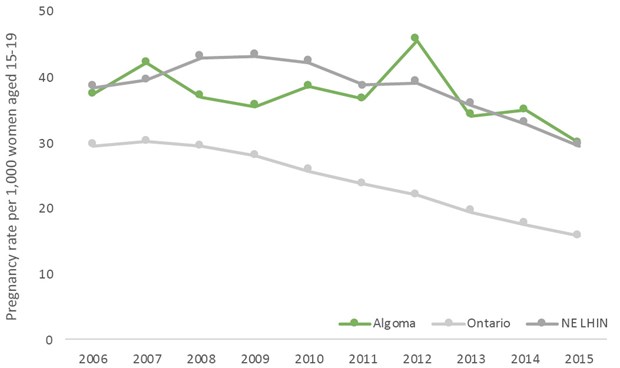
Adolescent mothers in Algoma do not do as well compared to older age groups, when it comes to having a healthy pregnancy. Compared to older pregnant women, more adolescent mothers:³
»» smoke during pregnancy,
»» use alcohol during pregnancy,
»» use illegal substances during pregnancy,
»» are not taking the recommended amount of folic acid for healthy brain and spinal cord development,
»» are not seeing a health care provider for a prenatal visit during their first trimester, and
»» have newborns who need to be admitted to intensive care at birth.
- At this time, there is very little information on how many adolescent pregnancies are planned versus unintentional pregnancies.
Healthy pregnancies in Algoma
- 1 in 4 Algoma mothers smoke during pregnancy.¹ Smoking during pregnancy can increase the chances of serious pregnancy complications, sudden infant death syndrome (SIDS), childhood asthma, and attention deficit hyperactivity disorder (ADHD).²
- Only 1 in 4 Algoma mothers take folic acid before and during pregnancy.¹ Folic acid is important for healthy brain and spinal cord development in the baby.³
- 1 in 4 Algoma mothers have a mental health challenge during pregnancy or postpartum, most commonly anxiety and/or depression.¹ This is a higher proportion of mothers compared to Ontario (25.6% versus 15.8%).¹
- 6.1% of Algoma mothers use alcohol or drugs during pregnancy.¹ This is comparable to 4.3% of mothers in Ontario. Alcohol and drug use during pregnancy can lead to fetal alcohol spectrum disorder (FASD) and other serious pregnancy and birth complications.4
|
Thinking of having a baby? Here are the top 5 things you can do for your baby’s health before becoming pregnant:5
|
Breastfeeding for a healthy start
- 64.3% of Algoma infants are exclusively breastfed after birth.¹ This is similar to 62.3% of infants for Ontario overall.¹
- Only 1 in 3 Algoma infants are exclusively breastfed during the first six months of life.6 Comparator data for Ontario is not available at this time.
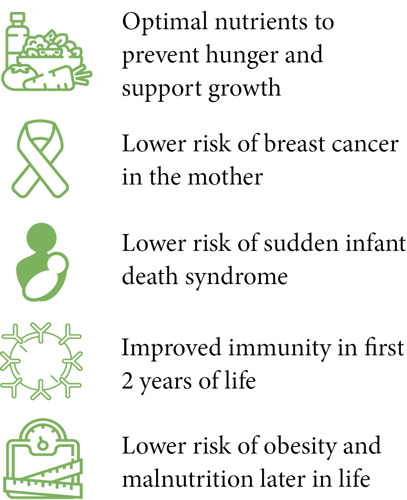
| Exclusive breastfeeding is recommended for the first 6 months of life. The World Health Organization also recommends continuing breastfeeding to 2 years of age or older, with complimentary foods.8 |
Focus on parents
- Many Algoma parents with infants face circumstances that make parenting even more challenging than it already is. These parents can benefit from social support, access to health care and income support.
- Algoma Public Health screens infants for risk factors related to healthy child development. In 2016, about 848 screens were completed as part of the Healthy Babies Healthy Children program. Results of these screens are presented below:
Algoma infants tend to be born into families with more risk factors for healthy child development compared to Ontario.¹
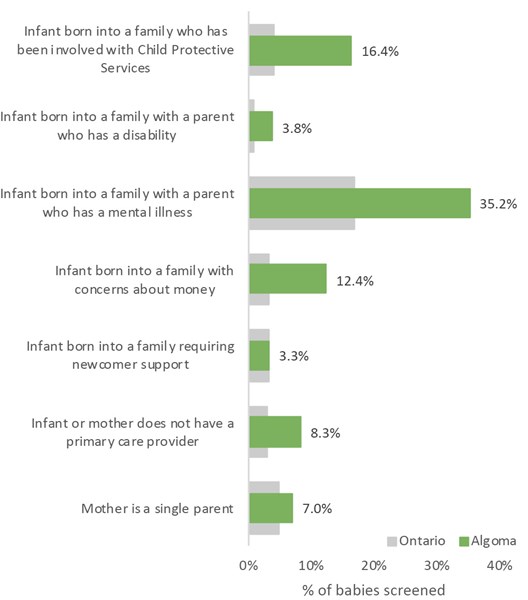
|
Tips for Positive Parenting:²
|
|
Acronyms:
NE LHIN: North East Local Health Integration Network HPV: Human papilloma-virus STI: Sexually transmitted infection
Important Stats:
Vaccine coverage Healthy behaviour prevalence
|
Key Messages:
- The majority of Algoma children and youth are up to date with their immunizations, which protects them from over a dozen different infectious diseases.
- Many Algoma children and youth continue to struggle with healthy eating, healthy weights, and body image.
- Algoma youth rank third best in Ontario for being physically active during free time, but are struggling with unhealthy behaviours such as cigarette smoking and cannabis use.
Childhood and school-based immunizations
- Overall, Algoma children and youth are most up-to-date with their immunizations compared to Ontario children and youth.¹ In Ontario, free immunizations are available for infants and school-aged children and youth through a publicly funded immunization program.
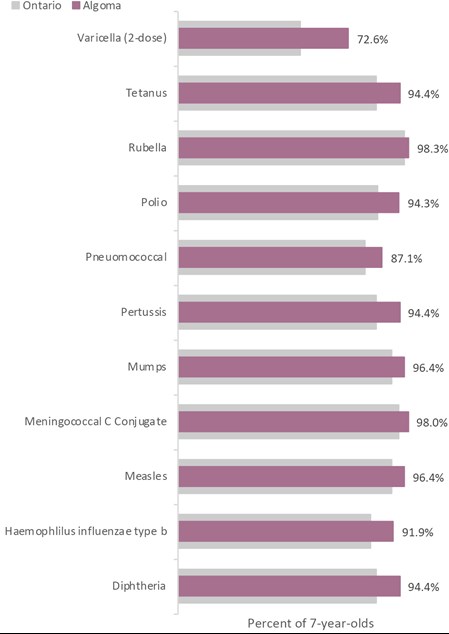
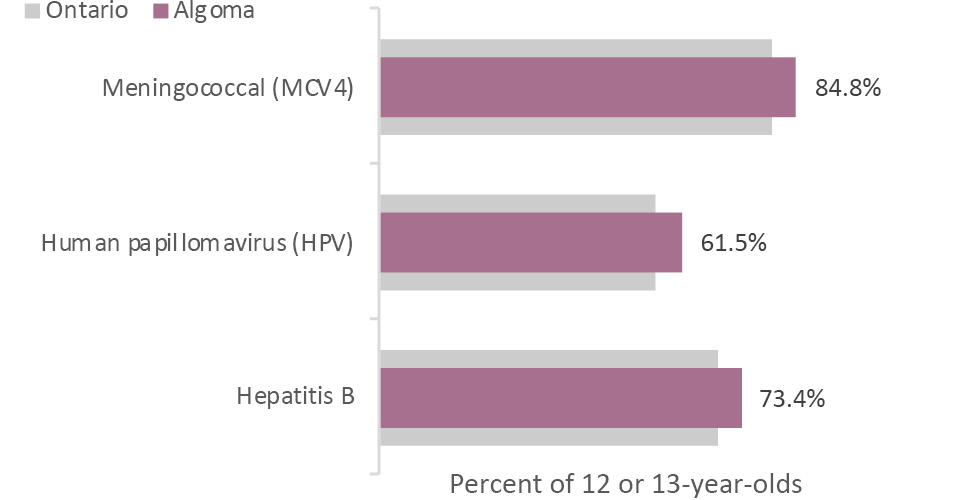
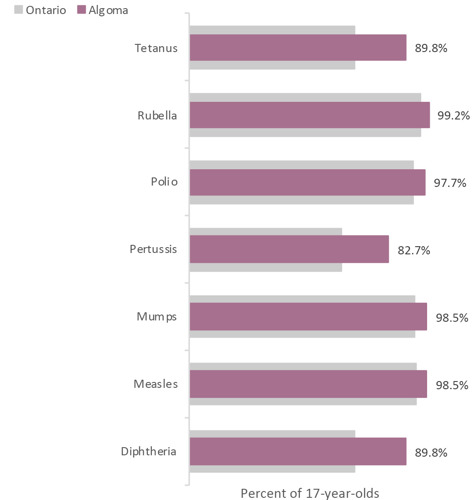
- The widespread vaccine coverage in Algoma youth provides strong protection against all of the infectious diseases in the graphs above. Additionally, the HPV vaccine protects against anal, oral and cervical cancer.²
Healthy eating, healthy weights and body image
- Nearly 80% of Algoma youth aged 12 to 17 years old do not eat fruits and vegetables at least five times a day or more.¹ This is comparable to 73.7% of NE LHIN youth and 75.4% of Ontario youth.¹
- About 1 in 4 (22.2%) youth aged 12 to 17 years old in Algoma are overweight or obese.¹ This is comparable to 27.3% of youth in the NE LHIN and 21.2% of Ontario youth.¹
- Eating disorders in children and youth aged 10 to 24 years old led to 39 hospitalizations in Algoma between 2014 and 2016. Hospitalization rates for an eating disorder in 2016 were as follows:²,³
»» 8.9 per 10,000 in Algoma,
»» 8.5 per 10,000 in the NE LHIN, and
»» 7.8 per 10,000 in Ontario.
|
How to encourage healthy eating and positive self-esteem in children:4
|
Healthy lifestyles
- Over 8 in 10 Algoma youth aged 12 to 19 years old are physically active during their free time.5 In fact, Algoma ranks third highest in Ontario for this healthy behaviour. In Ontario, 7 in 10 youth are physically active during their free time.5
- Only 73.6% of Algoma youth aged 12 to 19 years old have never smoked a cigarette.¹ This compares to 83.6% of youth in the NE LHIN and 89.7% of youth in Ontario.¹
- 28.3% of Algoma youth aged 12 to 19 years old have tried cannabis.6 In Ontario overall, 22.9% of youth have tried cannabis.6
Oral health
- 83.1% of Algoma youth aged 12 to 19 years old brush their teeth at least twice a day.7 Similarly, about 82% of Ontario youth brush their teeth at least twice a day.7
- 65.0% of Algoma primary school students do not have cavities, fillings, or missing teeth during dental screening.8 Provincial comparison data is not available at this time.
Healthy sexuality in young adults
- Just over 3 out of 4 young adults 15 to 24 years old in Algoma have had sex in their lifetime.¹ Compared to Ontario, Algoma young adults are less likely to use a condom or get checked for a sexually transmitted infection (STI).¹
Teens and young adults in Algoma have some riskier sexual health practices than the province.
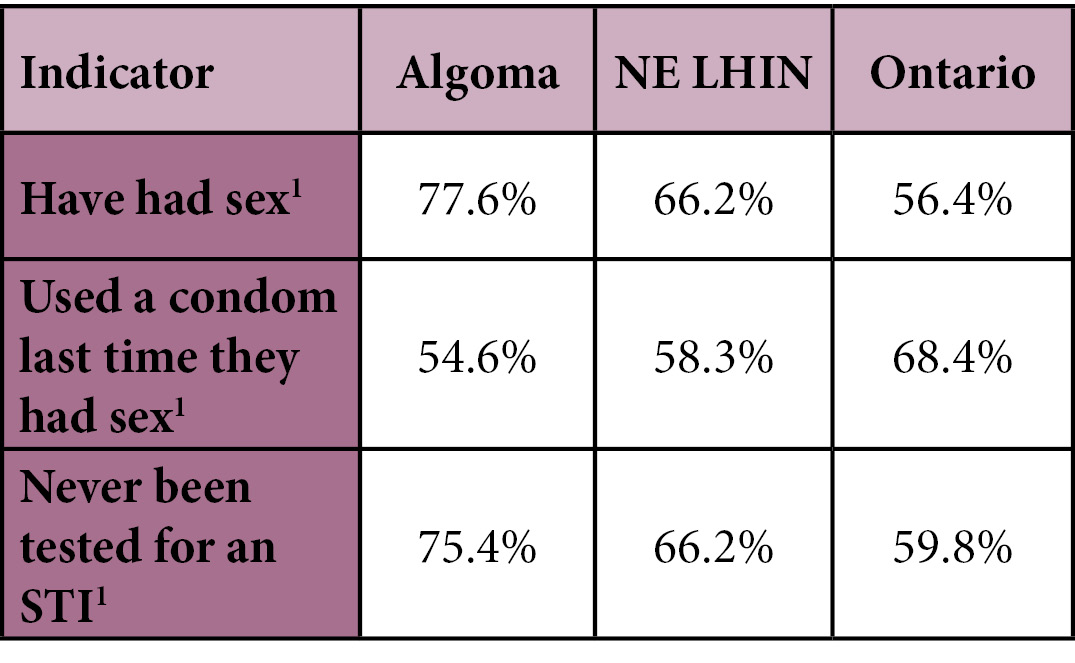
- Approximately 3.0% of adolescent women aged 15 to 19 years old in Algoma will experience a pregnancy each year.9 This statistic is 3.0% in the NE LHIN and 1.6% in Ontario.9
Chapter 5: Infectious Disease
|
Acronyms:
NE LHIN: North East Local Health Integration Network STI: Sexually transmitted infection MRSA: Methiccillin-resistant staphylococcus aureus VRE: Vancomycin-resistant enterococcus iGAS: Invasive group A streptococcus
Important Stats:
Outbreaks Infectious disease incidence |
Key Messages:
- Thanks to good hygiene, sanitation, and effective vaccines, our population is well-protected from most infectious diseases.
- Outbreaks of disease still happen from time to time, which means it is important to stay up to date with our immunizations.
- Hepatitis C continues to be a growing public health concern in Algoma.
Vaccine preventable diseases
• Algoma has only had one major outbreak of a vaccine-preventable disease in the past 10 years. In 2016, an outbreak of pertussis or “whooping cough” was confirmed in 112 people across multiple Algoma communities.¹ People of all ages were affected, but over half of cases were under the age of 15.¹
• Since 2008, none of the following major vaccine preventable diseases have been reported in Algoma: diphtheria, measles, mumps, poliomyelitis, rubella, tetanus.¹ Most Algoma children and youth are up to date with their immunizations,² which helps to protect them and the community from serious vaccine preventable diseases.
|
Protect against whooping cough:³
• Pregnant women, or women planning to become pregnant, are encouraged to speak with their health care provider to learn more about the Tdap vaccine. |
Influenza and other outbreak
- Every year, especially during the winter months, outbreaks of disease happen within most Algoma institutions, such as hospitals and long-term care facilities. Viruses cause most of these outbreaks, which are usually of respiratory disease (cold- or flu-like symptoms) or enteric disease (nausea, vomiting, diarrhea).
- During the November 2017 to April 2018 season, there were 17 respiratory outbreaks and 5 gastroenteritis outbreaks in Algoma institutions.4 Of the 17 respiratory outbreaks, 14 were due to the influenza virus.4
Blood-borne and sexually transmitted infections
- Hepatitis C rates are high in Algoma and the number of new cases of hepatitis C is still rising. In 2017, there were 83 people diagnosed with hepatitis C in Algoma, which was the highest number of new cases in a year since 2008.5 During the 5-year period between 2013 and 2017, Algoma’s rate* of new hepatitis C cases was higher than both the North East† and Ontario.5
- Chlamydia infections are the most common bacterial sexually transmitted infection in Algoma. In 2017, Algoma had 293 cases of chlamydia and between the 2013-2017 period, Algoma had a higher rate of chlamydia cases than Ontario but lower than the rate in the North East† overall.5
- Gonorrhea infections in Algoma have been on the rise since 2010. In 2017, Algoma had 39 cases of gonorrhea, which was a drop from 95 cases in 2016 and 77 cases in 2015.5 Algoma had a higher rate of gonorrhea cases during the 2013-2017 period than both the North East† overall and Ontario.5
- Algoma has lower rates of HIV and syphilis compared to Ontario.5
Key incidence rates* per 100,000 people between 2013 and 2017 in Algoma, the North East† and Ontario.5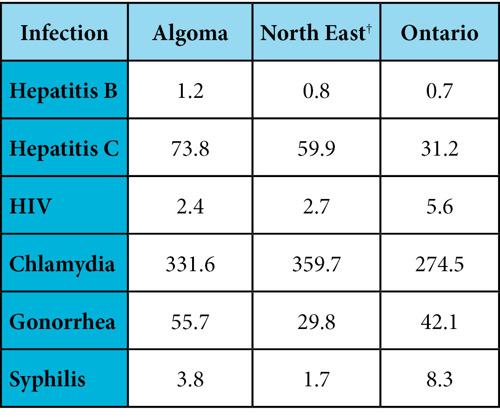
|
Protect against infectious disease:¹
|
Invasive group A streptococcus (iGAS)
- The number of iGAS cases in Algoma has increased, especially since the beginning of 2017.² In Algoma, this serious bacterial infection tends to affect those who are elderly or who have medical conditions such as diabetes, chronic wounds, or immune problems (24.6 % of cases between January 2012 and June 2018). Other high-risk groups include people who inject drugs (9.2% of cases in between January 2012 and June 2018) and people who are homeless or under housed (4.6% of cases between January 2012 and June 2018).²
- Other jurisdictions in Ontario have also seen increases in cases of iGAS in recent years.³‚4 iGAS is a reportable disease and Algoma Public Health continues to conduct surveillance of local cases.
Tuberculosis
- Algoma has one of the lowest rates of active tuberculosis in Ontario. Between 2005 and 2017, only six people were diagnosed with active tuberculosis in Algoma.5
Food- and water-borne illness
- Reported rates of food- and water-borne illness in Algoma are consistently lower than in Ontario. In 2017, rates* of food- and water-borne illness were as
follows:5
»» 48.4 cases per 100,000 people in Algoma,
»» 54.1 cases per 100,000 people in the North East,† and
»» 66.7 cases per 100,000 people in Ontario
Vector-borne illness
- Lyme disease was diagnosed and reported in six Algoma residents between 2013 and 2017. The rate* of Lyme disease between 2013 and 2017 is 1.0 per 100,000 people, compared to the Ontario rate of 2.8 per 100,000 people.5
Lyme disease is a bacterial disease which can be spread to humans through the bite of an infected blacklegged tick.
Algoma tick surveillance shows that 13.7% of identified ticks are blacklegged ticks; one in five of these blacklegged ticks carry Borrelia burgdorferi, the bacteria that causes Lyme disease.6
West Nile Virus disease is rare in Algoma. Since 2005, Algoma has only had two confirmed cases of West Nile Virus disease.5
From time to time, Algoma residents can get vector-borne illnesses while traveling. Since 2005, there have been eight Algoma residents became who ill with malaria after traveling abroad.5
|
Tips for preventing tick & mosquito bites:¹
• Use insect repellent containing DEET or Icaridin.
|
Health care-associated infections
Clostridium difficile infections happened 30 times in Algoma hospitals in 2017.² When patients take antibiotics, their normal gut bacteria can be destroyed, and infection from Clostridium difficile can happen. This infection can damage the bowel and cause diarrhea. Over the past five years, rates* of Clostridium difficile infection were as follows:³
»» 1.6 cases per 10,000 patient days in Algoma,
»» 2.2 cases per 10,000 patient days in the NE LHIN, and
»» 2.6 cases per 10,000 patient days in Ontario.
- Algoma Public Health and health care partners conduct ongoing surveillance of “superbugs” that are resistant to regular antibiotics. Every year, Algoma hospitals see zero to two cases of blood infection from methicillin-resistant Staphylococcus aureus (MRSA), and zero to one case of blood infection from vancomycin-resistant enterococcus (VRE).4
|
How can we help stop antibiotic resistance and the emergence of superbugs?5
|
Chapter 6: Injuries
|
Acronyms:
NE LHIN: North East Local Health Integration Network
Important Stats:
Injury-related hospitalization Injury-related mortality |
Key Messages:
Injuries cause a significant burden of illness in Algoma and are responsible for many premature deaths.
Falls are the most common reason for an injury-related hospitalization.
Intentional self-harm is a major cause of injury-related hospitalizations in young and working age adults.
Between 2008 and 2012, 5.8% of deaths in the Algoma were due to injuries.
Injury-related hospitalizations
- Residents of Algoma are more likely to be hospitalized because of an injury than NE LHIN residents and Ontario overall. Algoma’s hospitalization rate for injuries has remained consistent since 2007.¹‚² In 2017, rates of hospitalization per 100,000 people due to any injury were as follows:¹‚³
- 957.2 in Algoma (16.1% of hospitalizations),
- 881.6 in the NE LHIN (14.6% of hospitalizations)
- 574.6 in Ontario (13.6% of hospitalizations).
- Overall, falls is the number one type of injury that causes Algoma residents to be hospitalized. This is true for both men and women, and is also the case for the NE LHIN and for Ontario. A further breakdown of the top 5 causes of injury hospitalization by age can be found below.
- In younger adults, intentional self-harm is the number one cause of injury-related hospitalization. This is the case for 20 to 44-year olds in Algoma, the NE LHIN, and Ontario.¹
Falls
- Injuries from falls led to 604 hospitalizations of Algoma residents in 2016. Algoma’s falls hospitalization rate has been stable since 2003, and is higher compared to Ontario and the NE LHIN. Hospitalization rates per 100,000 people from falls are as follow:4
- 377.6 in Algoma,
- 321.8 in NE LHIN, and
- 285.2 in Ontario
- Algoma residents 75 years and older is the age group most likely to be hospitalized for falls. The Algoma rate for hospitalizations from falls in this age group is similar to the NE LHIN and to Ontario.4
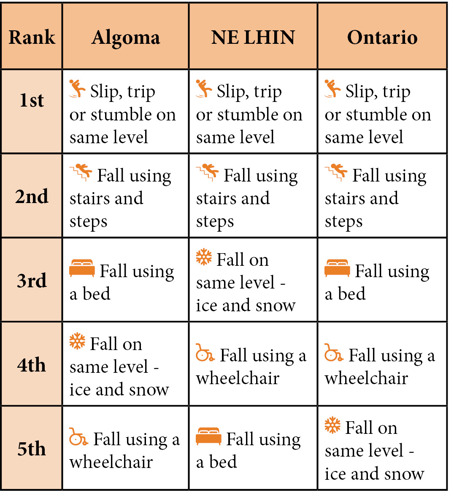
Intentional self-harm
- Algoma has a higher burden of illness from intentional self harm compared to the NE LHIN and Ontario. The 2016 hospitalization rates per 100,000 people for self-harm are as follows:4
»» 155.8 in the NE LHIN, and
»» 69.5 in Ontario.
- Women are more likely to be hospitalized for intentional self-harm than men.4 This is true for Algoma, the NE LHIN, and Ontario.4
- Youth and young adults are more likely to be hospitalized for intentional self-harm.4 Across Algoma, the NE LHIN, and Ontario, young people aged 10-19 years and 20-44 years are the age groups who are most likely to be hospitalized for intentional self-harm.4
Leading causes* of injury hospitalization (2016):

Injury-related deaths
- Between 2008 and 2012, 369 Algoma residents died because of an injury.¹ This accounted for 5.8% of all deaths in Algoma between 2008 and 2012. This is comparable to 6.4% of all deaths in the NE LHIN² and 6.1% of all deaths in Ontario.² The death rates per 100,000 people for injuries are as follows:¹
»» 57.1 in Algoma,
»» 41.7 in Ontario.
Leading causes* of injury-related death between 2008-2012¹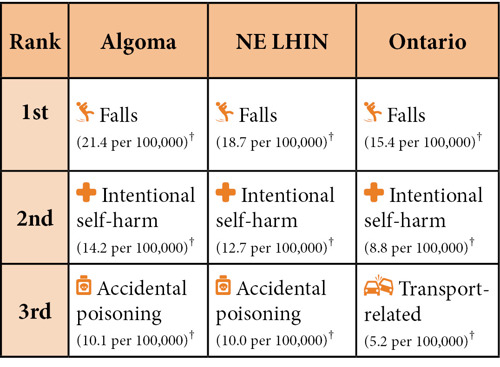
|
Ten easy ways to avoid falls:³
|
Chapter 7: Chronic Disease
|
Acronyms:
NE LHIN: North East Local Health Integration Network CPAG: Canadian Physical Activity Guidelines FASD: Fetal alcohol spectrum disorder LRADG: Low Risk Alcohol Drinking Guidelines SIDS: Sudden infant death syndrome COPD: Chronic obstructive pulmonary disorder
Important Stats: Health behaviours and chronic disease prevalence Cancer screening rates Cancer incidence and mortality |
Key Messages:
- With age, most Algoma residents are affected by one or more chronic diseases, like cancer, heart disease, lung disease, and arthritis.
- Although Ontario’s smoking rates are the lowest they have ever been (15.5%), Algoma still has very high rates of smoking – nearly 30%.
- Algoma has room for improvement when it comes to other preventive and healthy behaviours like eating more fruits and vegetables, being physically active, and limiting alcohol.
- 1 in 4 deaths in Algoma are due to cancer. Lung cancer is the top cancer in Algoma and is more common than in Ontario.
Healthy behaviours
Healthy behaviours, sometimes called “lifestyle behaviours,” can have a big impact on our health. Unhealthy behaviours like smoking and drinking alcohol, and healthy behaviours like being active and eating plenty of fruits and vegetables, all have a major role in whether we develop heart disease, lung disease, stroke, diabetes, and cancer. As presented in Chapter 2: Life Expectancy, these chronic diseases are the leading cause of illness and death in Algoma and in Ontario.¹ This section describes how Algoma communities are doing in terms of lifestyle behaviours, and what we can all do to stay healthy and lower our risk of chronic disease.Algoma’s population has room to improve on our healthy behaviours, most notably reducing our smoking levels.
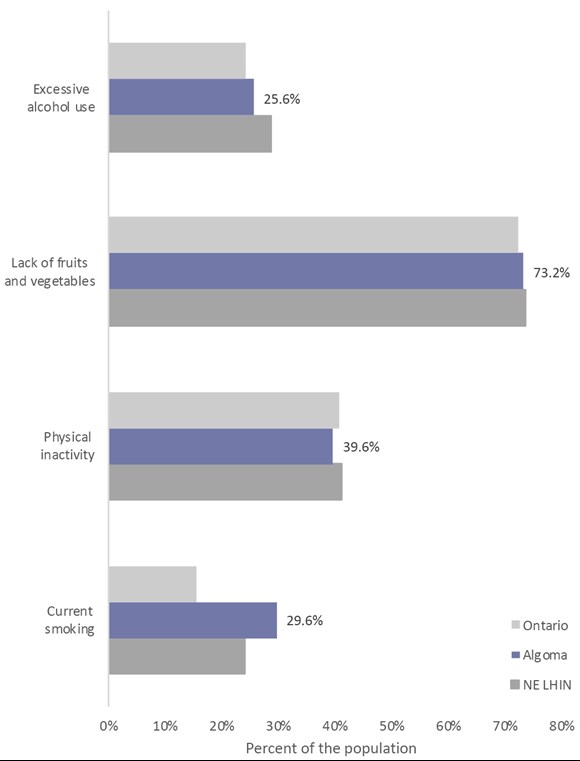
|
Checklist for health:
• If you drink alcohol, follow Canada’s Low-Risk Alcohol Drinking Guidelines.
• Get regular Pap tests, mammograms, and colon cancer checks. These are easy ways to help catch cancer early. |
Alcohol
- Over 1 in 4 Algoma residents are heavy drinkers,* which means that they are consuming alcohol in unhealthy, risky amounts.²
- Alcohol takes a big toll on our health, leading to cancer, alcohol use disorders, brain damage, liver disease, stomach ulcers, diabetes, stroke and a host of other physical and mental complications.³
- Alcohol use can affect families and communities through stress on relationships, money problems, violence, injuries and difficulties at work.³
|
Drinking alcohol? Know how to reduce your risks:²
• Pregnant? No amount of alcohol is safe. Drinking when pregnant can cause fetal alcohol spectrum disorder (FASD).
• Be a positive role model for your children: Drink in moderation, avoid glamorizing alcohol, be a responsible host and critically think about your reasons for consuming alcohol and how you can modify your personal behaviours to reduce short and long-term risks for yourself and your family. |
Fruit and vegetable consumption
- The majority of Algoma residents do not eat enough fruits and vegetables. 73.2% of Algoma residents aged 12 and over eat fruits and vegetables less than 5 times a day.¹
- Eating a diet rich in fruits and vegetables reduces our risk of obesity, heart disease, stroke, and many types of cancer.²
|
Better ways to eat fruits and vegetables every day:
• Aim for half of your plate to include vegetables.
• Include at least one fruit/vegetable with snacks.
• Enjoy a variety of colours, especially dark green and orange vegetables.
|
Tobacco use
- Tobacco use is the leading cause of preventable illness and death in Ontario, and Algoma’s smoking rate* is almost twice as high as the province’s (29.6% vs. 15.5%).¹
- 1 in 4 Algoma mothers smoke during pregnancy. Smoking during pregnancy is even more common among adolescent mothers.5
- Only 73.6% of Algoma youth aged 12 to 19 say they have never smoked a cigarette.¹ In Ontario, 89.7% of youth report never having smoked a cigarette.¹
- Smoking rates are highest in Algoma adults aged 20 to 44 years old at 37.8% and adults aged 45 to 64 at 38.8%.¹
|
Just a few reasons to butt out:6,7
• Many tobacco users develop cancer, heart disease, stroke, asthma and or chronic obstructive pulmonary disease (COPD).
• Benefits of quitting include: decreased blood pressure, improved lung health and a reduced risk of heart attack, stroke and cancers.
Stopping tobacco use takes preparation, action and maintenance. It’s a lot of hard work, but it’s never too late to start.
• Involve family and friends who understand the challenges of quitting, and are there to give encouragement and support throughout the quit journey. |
Physical activity
- 39.6% of Algoma residents do not get enough physical activity.¹ The Canadian Physical Activity Guidelines recommend that we have at least 150 minutes of moderate-to-vigorous physical activity per week, in sessions of 10 minutes or more.8
- Lack of physical activity in Algoma is more common with older age, as just 30.5% of 20 to 44-year-olds do not meet the Canadian Physical Activity Guidelines versus 41.2% of 45 to 64-year-olds and 54.9% of seniors aged 65 years and over.¹
|
Research shows that being active for at least 150 minutes each week will reduce our risk of heart disease, stroke, high blood pressure, type 2 diabetes, obesity and cancer. And 10 minutes at a time is all we need to begin. Pick an activity that is enjoyable and easy to do often. For example,
Limit time spent sitting. Research shows that sedentary behaviour increases the risk of colon cancer. If you work at a desk, take standing breaks, stand while on the phone or stretch throughout the day.² |
Chronic disease risk factors
• Approximately 60.1% of adults in Algoma report being overweight or obese.³ This is comparable to the NE LHIN at 60.1% and to Ontario at 50.7%.³ Being overweight or obese contributes to high blood pressure, heart disease, type 2 diabetes, sleep apnea, mental health problems, and a wide range of cancers.4
• Approximately 18.6% of residents in Algoma report living with high blood pressure.³ This is comparable to the NE LHIN at 21.1% and is worse than Ontario at 17.4%.³ High blood pressure can lead to heart disease, heart attacks, stroke, and kidney failure.5
• Approximately 10.1% of residents in Algoma report living with high blood cholesterol. This is comparable to 13.2% of residents in the NE LHIN and to 13.0% of Ontarians. High cholesterol is a risk factor for coronary artery disease, which can lead to heart attacks and stroke.5
Chronic disease burden
- Many people in Algoma live with one or more chronic diseases³, and chronic diseases are a leading cause of death in older adults.6
- The percentage of the population who have common chronic diseases* in Algoma, the NE LHIN and Ontario are shown below:
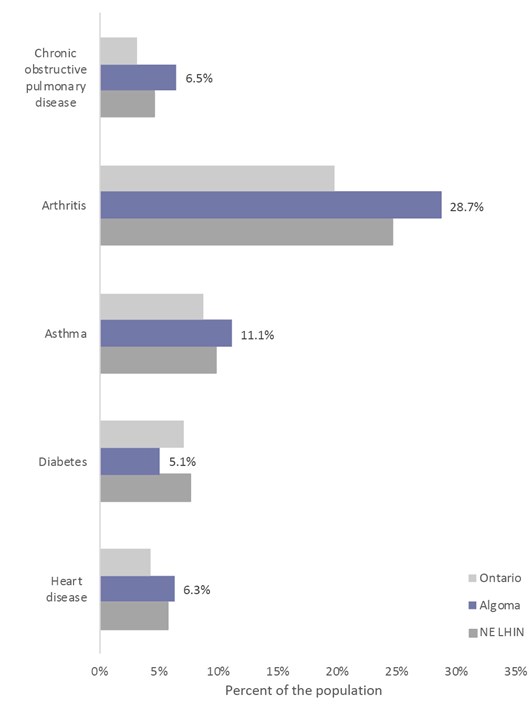
- Older adults are most affected by major chronic disease. Among Algoma adults aged 65 years and older, 17.3% have diabetes, 16.5% have heart disease, 8.4% have chronic obstructive pulmonary disorder and 61.0% have some form of arthritis.³
Cancer
- Cancer is a major cause of illness in Algoma. Over 1,150 new cases of cancer were diagnosed in Algoma residents in 2013.¹
- Breast Cancer, lung cancer and prostate cancer are more commonly diagnosed in Algoma compared to Ontario.¹ This may be due to cancer related behaviours such as drinking alcohol and smoking. It may also be related to the number of people who choose to get tested for cancer. Exposures from work or the environment may also play a role.
Rate of newly diagnosed cancer cases per 100,000 people for common cancers.¹
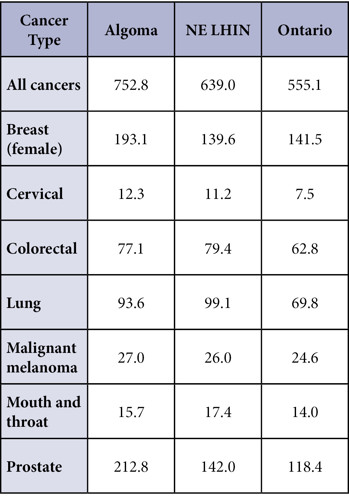
Cancer screening
- Ontario has screening programs for three major types of cancer: breast cancer, cervical cancer and colon cancer. Finding these cancers early can lead to better treatment and improved chances of survival.
- Many Algoma residents get screened for cancer if they are eligible, but Algoma screening rates are lower than Ontario’s as shown in the table below:
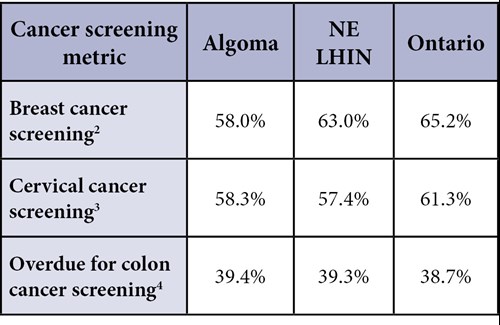
Cancer-related deaths
- About 1 in 4 deaths in Algoma are due to cancer, which is similar to the North East LHIN and to Ontario.¹ In 2012, there were over 360 deaths from cancer in Algoma.¹ In both Algoma and Ontario, men are more likely to die from cancer than women.¹
- Lung cancer is the major type of cancer where death rates are significantly higher in Algoma, compared to Ontario.²
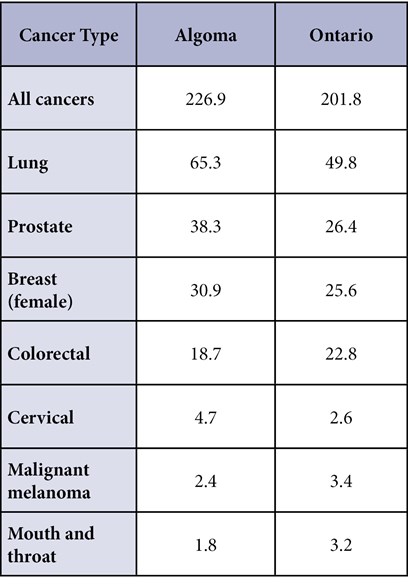
|
Acronyms:
NE LHIN: North East Local Health Integration Network THC: Tetrahydrocannabinol
Important Stats:
Suicide mortality Self-harm hospitalization Mental health and addiction hospitalization Drug toxicity hospitalization |
Key Messages:
- Most people in Algoma report positive mental health; however, many Algoma residents still live with the challenges of life stress, job stress and mental illness.
- Serious mental health issues in Algoma include problematic substance use, self-harm and suicide.
- Health harms from opioid use is an ongoing concern for Algoma communities.
Self-reported mental health
- About two-thirds of Algoma residents report having very good or excellent mental health, and 9 out of 10 Algoma residents feel satisfied or very satisfied with their lives.¹ This is similar to the NE LHIN and Ontario.¹
- More than 1 in 5 people in Algoma have quite a bit or a lot of stress, either in their lives or at their jobs.¹ This is similar to the NE LHIN and Ontario.¹
- Just over 7 out of 10 Algoma residents report a strong sense of belonging to their local community.¹ This is similar to the NE LHIN and Ontario.¹
- A greater percentage of Algoma residents report being diagnosed with a mood disorder, at 15.1%, than Ontario residents at 8.7%.¹ 10.6% of NE LHIN residents report having a mood disorder.¹ Mood disorders include depression, bipolar disorder, mania or dysthymia. Algoma residents report being diagnosed with anxiety disorders at a similar percentage to the NE LHIN and Ontario.¹ Anxiety disorders include phobias, obsessive compulsive disorder and panic disorders.
|
Achieve mental fitness, one step at a time:²
|
Health burden of serious mental illness
- Hospitalization rates from self-harm are higher in Algoma compared to Ontario, although there has been some improvement since 2010.³−5 Females in Algoma are more likely to be hospitalized from self-harm-related causes than males. In 2017, hospitalization rates for self-harm were:³−5
- 90.2 per 100,000 people in Algoma,
- 90.1 per 100,000 people in the NE LHIN, and
- 39.9 per 100,000 people in Ontario.
- Rates of hospitalization due to mental health or addictions are continuing to rise in Algoma, the NE LHIN, and Ontario.³−5 Females in Algoma are more likely to be hospitalized than males. As shown below, in 2017, Algoma rates of hospitalization due to mental health or addictions were similar to the NE LHIN, and higher than Ontario:³−5
- 553.9 per 100,000 people in Algoma,
-
520.1 per 100,000 people in the NE LHIN, and
-
184.3 per 100,000 people in Ontario.
- Deaths by suicide in Algoma are comparable to the NE LHIN and higher than Ontario.4-6 Between 2008 and 2012, the rates of death by suicide were:
- 14.2 deaths per 100,000 people in Algoma,
- 12.6 deaths per 100,000 people in the NE LHIN, and
- 8.7 deaths per 100,000 people in Ontario.
Substance use
- Alcohol and tobacco are the most commonly used substances by Algoma residents.¹ See Chapter 7 for further information regarding the chronic disease burden related to alcohol and tobacco.
- Nearly 4 out of 10 Algoma residents have used an illicit drug in their lifetime.¹ This is similar to the percentage of NE LHIN residents but higher than the 3 out of 10 Ontario residents.¹ The most common drug that Algoma residents reported having tried in their lifetime is cannabis. A more detailed breakdown can be found in the table below.
- Over 4 out of 10 Algoma residents have used cannabis more than once in their lifetime.¹ This is similar to NE LHIN residents at 39.2% and higher than Ontario at 31.2%.¹
The majority of Algoma residents report staying away from illicit drugs¹
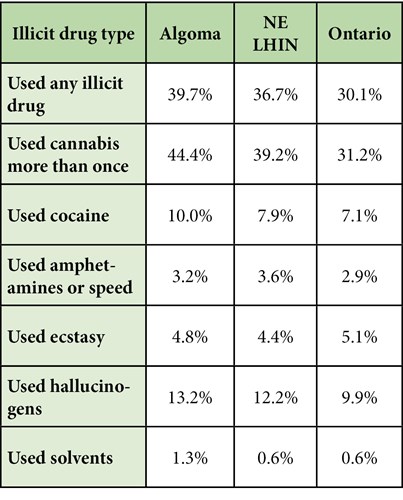
|
New! Canada’s Lower-Risk Cannabis Use Guidelines:²
• Delay use until later in life to avoid harming brain development.
• Limit and reduce how often you use to prevent injuries.
• Find and choose lower-risk products; look for low tetrahydrocannabinol (THC) content. |
Spotlight on opioids and overdose
- Both Algoma and the NE LHIN have higher rates of hospitalization due to drug toxicity than Ontario. In 2017, hospitalization rates for non-medicinal drug toxicity were as follows:³‚4
- 133.1 per 100,000 people in Algoma,
- 132.0 per 100,000 people in the NE LHIN, and
- 62.5 per 100,000 people in Ontario.
- Opioids are a major cause of drug toxicity hospitalizations in Algoma. The rates of hospitalizations for opioid toxicity in 2017 were as follows:³‚4
- 45.7 per 100,000 people in Algoma,
- 27.2 per 100,000 people in the NE LHIN, and
- 14.6 per 100,000 people in Ontario.
- There were 15 deaths due to opioid overdoses in Algoma in 2016. This translates to a rate of 13.0 deaths per 100,000 people, which is almost double the rate of the NE LHIN at 8.4 deaths per 100,000 people and more than double Ontario at 6.2 deaths per 100,000 people.
- Nearly 1 in 100 people in Algoma receive opioid addiction treatment with methadone or buprenorphine/ naloxone (i.e. Suboxone).6 In 2016, the percentage of people who were dispensed methadone or buprenorphine/naloxone to treat opioid addiction were as follows:6
- 0.8% of people in Algoma,
- 0.9% of people in the NE LHIN, and
- 0.4% of people in Ontario.
Canadian Community Health Survey (CCHS)
The CCHS applies to the general population 12 years of age and older. Because certain groups are not included on the survey, CCHS data does not represent people who are living in Indigenous communities, full-time members of the Canadian Forces, institutionalized individuals or children in foster care.
Canadian Census
The Census of the Population is required by law to be conducted every five years and is the primary source of sociodemographic data in Canada. We use this information to monitor the age and structure of our population, as well as to monitor many of the social determinants of health. The Canadian Census captures the entire Canadian population. The long-form census, which collects more detailed information from 25% of Canadian households, excludes Canadian citizens living temporarily in other countries, full-time members of the Canadian Forces stationed outside Canada, persons living in institutional collective dwellings like hospitals, and persons living in work camps, hotels and student residences. Additionally, some Indigenous communities may not choose to be enumerated.
Discharge Abstract Database
The Discharge Abstract Database captures all hospitalizations and subsequent discharges of Ontario residents. We use this data to monitor the sources of more severe illnesses and injuries, compared to the data contained within the National Ambulatory Care Reporting System.
integrated Public Health Information System (iPHIS)
The integrated Public Health Information System (iPHIS) is a database and information system that is used to support surveillance for all reportable diseases of public health significance in Ontario and across Canada. We use this data to monitor newly acquired and historic cases of major diseases that could pose a threat to the health of the population if left untreated. A full list of these diseases can be found at: http://www.health.gov.on.ca/en/pro/programs/publichealth/oph_standards/infdispro.aspx
The integrated Public Health Information System (iPHIS) captures information on all individuals seeking healthcare services for diseases that are considered reportable in Ontario that are reported to public health.
National Ambulatory Care Reporting System (NACRS)
The National Ambulatory Care Reporting System captures all ambulatory visits, also known as emergency visits, and is a major source of data on illness and injury in the population. We use this database to understand the reasons why our residents are visiting the hospital and how frequently different types of visits happen.
Panorama
Immunization coverage, or the percent of the population that is protected against a specific vaccine preventable disease, is ultimately captured and reported using a database called Panorama and accessed through the Panorama Enhanced Analytical Reporting tool. We use this data to perform surveillance and assessment of the data contained within immunization records.
Panorama captures information about immunization records for all individuals attending schools in Ontario.
Ontario Mortality Data
The Ontario Mortality Data, or Vital Statistics Death database, contains data from the Office of the Registrar General using death certificates completed by physicians. All deaths happening within Ontario are captured this way and we use this data to monitor what the leading causes of death are and whether those deaths were preventable.The Ontario Mortality Data set includes data on registered Ontario residents with an Ontario postal code.
Population Estimates
The Population Estimates database is a source of information about the age and structure of the population that is refreshed annually, compared to the 5 year updates from the Census. The database uses estimates produced by Statistics Canada and we use it most often to calculate rates on a yearly basis.
Population Projections
The Population Projections database for 2017 to 2041 was calculated using age and sex data from a Statistics Canada preliminary 2017 base file and takes into account births, deaths and five migration components. We use this data to calculate rates when population estimates are not available for the most recent year and to help provide context for health issues in the future.










